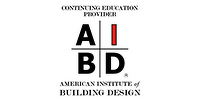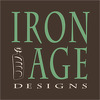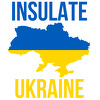
American Institute of Building Design
The American Institute of Building Design (AIBD), a nonprofit professional organization established in 1950, strives to protect and enhance our member’s ability to practice their profession. AIBD is committed to providing quality continuing education to ensure that our members remain current with technology, materials, and building codes.
Click to Learn More About the American Institute of Building Design
Visit www.aibd.org and Join Now!
Scan this code with your mobile device camera to take this page on-the-go!

https://redirect.aecdaily.com/s369432/www.aecdaily.com/course/923938

 The architectural uses for perforated metal span a wide variety of interior and exterior applications for residential, industrial, and commercial projects. Reviewed in this course are the applications and the specification considerations for standard and custom perforated metal, along with a discussion on how it is used to sculpt light, control sound, and compose views.
The architectural uses for perforated metal span a wide variety of interior and exterior applications for residential, industrial, and commercial projects. Reviewed in this course are the applications and the specification considerations for standard and custom perforated metal, along with a discussion on how it is used to sculpt light, control sound, and compose views.
Scan this code with your mobile device camera to take this page on-the-go!

https://redirect.aecdaily.com/s831648/www.aecdaily.com/course/849407

 The Americans with Disabilities Act (ADA) applies to all state and local government agencies, commercial facilities, and public entities that have “places of public accommodation.” Presented in this course are the fundamentals of what accessibility means in terms of architectural door hardware specification. Topics include available hardware technology, the criteria for interior and perimeter access, and the codes and guidelines pertaining to the ADA requirements that affect door hardware selection.
The Americans with Disabilities Act (ADA) applies to all state and local government agencies, commercial facilities, and public entities that have “places of public accommodation.” Presented in this course are the fundamentals of what accessibility means in terms of architectural door hardware specification. Topics include available hardware technology, the criteria for interior and perimeter access, and the codes and guidelines pertaining to the ADA requirements that affect door hardware selection.
Scan this code with your mobile device camera to take this page on-the-go!

https://redirect.aecdaily.com/s1081629/www.aecdaily.com/course/1106239

 Wildfires are becoming more common and severe, posing a significant threat to communities worldwide. Architects and the building industry must adopt a proactive approach to address this issue. In this course, we explore innovative and eco-friendly wildfire defense systems, which can play a vital role in protecting our communities and the environment from the harmful effects of wildfires and addressing the current home insurance crisis.
Wildfires are becoming more common and severe, posing a significant threat to communities worldwide. Architects and the building industry must adopt a proactive approach to address this issue. In this course, we explore innovative and eco-friendly wildfire defense systems, which can play a vital role in protecting our communities and the environment from the harmful effects of wildfires and addressing the current home insurance crisis.
Scan this code with your mobile device camera to take this page on-the-go!

https://redirect.aecdaily.com/s728117/www.aecdaily.com/course/867509

 In response to steadily growing demands for more and more storage capacity and the costs and energy required to implement that storage, data center design is now focusing on solutions that conserve energy, materials, money, and space. This course explores the current influences that directly or indirectly affect energy usage and management, the resulting trends in data center development, and how containment strategies enable designers to optimize energy efficiency and create facilities with minimal environmental footprints.
In response to steadily growing demands for more and more storage capacity and the costs and energy required to implement that storage, data center design is now focusing on solutions that conserve energy, materials, money, and space. This course explores the current influences that directly or indirectly affect energy usage and management, the resulting trends in data center development, and how containment strategies enable designers to optimize energy efficiency and create facilities with minimal environmental footprints.
Scan this code with your mobile device camera to take this page on-the-go!

https://redirect.aecdaily.com/s1048457/www.aecdaily.com/course/1058538

 Identify key fenestration design criteria that will fortify buildings against ballistic, blast, forced entry, and environmental threats.
Identify key fenestration design criteria that will fortify buildings against ballistic, blast, forced entry, and environmental threats.
Scan this code with your mobile device camera to take this page on-the-go!

https://redirect.aecdaily.com/s12454/www.aecdaily.com/course/969706

 Exterior shading devices offer a number of advantages that contribute to a more sustainable building, including minimizing cooling costs, reducing peak electricity demand, and controlling glare. These benefits result in greater occupant comfort and improved productivity. This course provides a review of exterior aluminum shading device systems, including the components, finishes, and design and engineering considerations, as well as a discussion of how shading strategies contribute to LEED® certification.
Exterior shading devices offer a number of advantages that contribute to a more sustainable building, including minimizing cooling costs, reducing peak electricity demand, and controlling glare. These benefits result in greater occupant comfort and improved productivity. This course provides a review of exterior aluminum shading device systems, including the components, finishes, and design and engineering considerations, as well as a discussion of how shading strategies contribute to LEED® certification.
Scan this code with your mobile device camera to take this page on-the-go!

https://redirect.aecdaily.com/s8761/www.aecdaily.com/course/792196

 This course focuses on barrier free shower design and installation. Following a brief review of the reasons, benefits, and legal requirements for barrier free showers it summarizes the features and attributes of shower assemblies, relevant industry standards, waterproofing membranes and drains, best practices, installation methodology, installation tips and techniques, and walk/roll in showers. It includes a review of the design considerations and advice for the creation of perfectly performing showers which follow the latest design trends.
This course focuses on barrier free shower design and installation. Following a brief review of the reasons, benefits, and legal requirements for barrier free showers it summarizes the features and attributes of shower assemblies, relevant industry standards, waterproofing membranes and drains, best practices, installation methodology, installation tips and techniques, and walk/roll in showers. It includes a review of the design considerations and advice for the creation of perfectly performing showers which follow the latest design trends.
Scan this code with your mobile device camera to take this page on-the-go!

https://redirect.aecdaily.com/s719/www.aecdaily.com/course/870117

 Single-skin metal siding can be used for a wide range of projects, from commercial buildings to educational, healthcare, residential, agricultural, and even high-end architectural designs. These siding panels can also contribute to green designs and certification programs. This course explores the different types of single-skin metal siding, specification details, and performance and design considerations.
Single-skin metal siding can be used for a wide range of projects, from commercial buildings to educational, healthcare, residential, agricultural, and even high-end architectural designs. These siding panels can also contribute to green designs and certification programs. This course explores the different types of single-skin metal siding, specification details, and performance and design considerations.
Scan this code with your mobile device camera to take this page on-the-go!

https://redirect.aecdaily.com/s19829/www.aecdaily.com/course/886840

 People spend more than 90% of their time indoors; incorporating sunrooms, conservatories, greenhouses, and/or other glass structures into homes or workplaces can be an effective way to reap the benefits of daylight. The positive impacts of incorporating more natural light into your lifestyle can be seen through energy savings, increase of productivity, and improvement of overall well-being. This presentation reviews strategies and design options to create unique overhead structures, standing structures, and vertical glazing systems that are energy efficient, comfortable, and functional.
People spend more than 90% of their time indoors; incorporating sunrooms, conservatories, greenhouses, and/or other glass structures into homes or workplaces can be an effective way to reap the benefits of daylight. The positive impacts of incorporating more natural light into your lifestyle can be seen through energy savings, increase of productivity, and improvement of overall well-being. This presentation reviews strategies and design options to create unique overhead structures, standing structures, and vertical glazing systems that are energy efficient, comfortable, and functional.
Scan this code with your mobile device camera to take this page on-the-go!

https://redirect.aecdaily.com/s921773/www.aecdaily.com/course/1009739

 Changing climate and land use patterns have necessitated a greater focus on stormwater management. The trench drain industry has developed in a rather fragmented way over the decades, with each manufacturer using their own unique reference points for dimension, load rating, and other criteria. The purpose of this course is to clear up the resulting confusion and provide best practices and a real-world understanding of the multiple variables at play on the project level.
Changing climate and land use patterns have necessitated a greater focus on stormwater management. The trench drain industry has developed in a rather fragmented way over the decades, with each manufacturer using their own unique reference points for dimension, load rating, and other criteria. The purpose of this course is to clear up the resulting confusion and provide best practices and a real-world understanding of the multiple variables at play on the project level.
Scan this code with your mobile device camera to take this page on-the-go!

https://redirect.aecdaily.com/s1096186/www.aecdaily.com/course/1100786

 The war in Ukraine has left thousands living in substandard housing conditions, insufficient for winter weather. This course reviews a solution developed by a British engineer that addresses the pressing problem of delivering replacement windows in a war zone to improve thermal comfort in Ukrainian homes.
The war in Ukraine has left thousands living in substandard housing conditions, insufficient for winter weather. This course reviews a solution developed by a British engineer that addresses the pressing problem of delivering replacement windows in a war zone to improve thermal comfort in Ukrainian homes.
Scan this code with your mobile device camera to take this page on-the-go!

https://redirect.aecdaily.com/s1125667/www.aecdaily.com/course/1152569

 In this course, we will review the history and evolution of synthetic turf, the most popular applications, and various types of turf intended for different uses. We will also review synthetic turf installation basics, present some insight into the manufacturing process, explore recent innovations, and conclude with detailed specifications for selecting the right type of turf.
In this course, we will review the history and evolution of synthetic turf, the most popular applications, and various types of turf intended for different uses. We will also review synthetic turf installation basics, present some insight into the manufacturing process, explore recent innovations, and conclude with detailed specifications for selecting the right type of turf.
Scan this code with your mobile device camera to take this page on-the-go!

https://redirect.aecdaily.com/s2580/www.aecdaily.com/course/1057157

 Soft flooring has experienced a surge in popularity in recent years due to its aesthetics, lower costs, durability, and ease of care. This course discusses how to create the optimal soft flooring system through proper substrate and surface preparation.
Soft flooring has experienced a surge in popularity in recent years due to its aesthetics, lower costs, durability, and ease of care. This course discusses how to create the optimal soft flooring system through proper substrate and surface preparation.
Scan this code with your mobile device camera to take this page on-the-go!

https://redirect.aecdaily.com/s681831/www.aecdaily.com/course/870548

 Various control strategies are used to prevent rain from penetrating a building envelope and entering a building assembly. This course compares exterior wall metal cladding systems and takes an in-depth look at the design options, testing, specifications, environmental implications, and the detailing of single-skin metal panel systems as used in a pressure-equalized rainscreen (PER) application.
Various control strategies are used to prevent rain from penetrating a building envelope and entering a building assembly. This course compares exterior wall metal cladding systems and takes an in-depth look at the design options, testing, specifications, environmental implications, and the detailing of single-skin metal panel systems as used in a pressure-equalized rainscreen (PER) application.
Scan this code with your mobile device camera to take this page on-the-go!

https://redirect.aecdaily.com/s13907/www.aecdaily.com/course/903646

 Concrete-faced insulated products are composite prefinished panels that are used to construct walls and roofing assemblies to maximize the energy efficiency, durability, and performance of a building envelope. This course discusses the design criteria used in designing energy-efficient buildings using concrete-faced continuous insulation systems for low-slope roofing, walls, and foundations. The functional and physical features of protective membrane roof (PMR) systems, concrete-faced insulated panels for walls and foundations, and concrete structural insulated panels (CSIPs) are evaluated.
Concrete-faced insulated products are composite prefinished panels that are used to construct walls and roofing assemblies to maximize the energy efficiency, durability, and performance of a building envelope. This course discusses the design criteria used in designing energy-efficient buildings using concrete-faced continuous insulation systems for low-slope roofing, walls, and foundations. The functional and physical features of protective membrane roof (PMR) systems, concrete-faced insulated panels for walls and foundations, and concrete structural insulated panels (CSIPs) are evaluated.
Scan this code with your mobile device camera to take this page on-the-go!

https://redirect.aecdaily.com/s10851/www.aecdaily.com/course/1141237

 Often the largest access point in a building, sectional door systems play a significant role in controlling energy costs and supporting sustainable design in residential and commercial buildings. This course explores the specification considerations and the different types of sectional garage doors, as well as their role in enhancing the thermal performance of homes and commercial buildings.
Often the largest access point in a building, sectional door systems play a significant role in controlling energy costs and supporting sustainable design in residential and commercial buildings. This course explores the specification considerations and the different types of sectional garage doors, as well as their role in enhancing the thermal performance of homes and commercial buildings.
Scan this code with your mobile device camera to take this page on-the-go!

https://redirect.aecdaily.com/s632921/www.aecdaily.com/course/835833

 Redwood offers warmth, character, durability, and strength in products from sustainably managed and harvested forests. This course provides insights into forestry practices and the environmental benefits of redwood lumber, and compares redwood with other common decking materials. Details are presented on how to differentiate and specify grades of redwood; finishing options and methods are also discussed. The course concludes with examples of applications that showcase the unique beauty and attributes of redwood.
Redwood offers warmth, character, durability, and strength in products from sustainably managed and harvested forests. This course provides insights into forestry practices and the environmental benefits of redwood lumber, and compares redwood with other common decking materials. Details are presented on how to differentiate and specify grades of redwood; finishing options and methods are also discussed. The course concludes with examples of applications that showcase the unique beauty and attributes of redwood.
Scan this code with your mobile device camera to take this page on-the-go!

https://redirect.aecdaily.com/s18122/www.aecdaily.com/course/1103482

 Growing and concentrating populations, shifting weather patterns, increasing frequency and ferocity of storm events, disappearing water supplies, and rising costs have made providing potable water and managing other water-related issues increasingly difficult for many communities. This course explores their many water issues and how they adapt their management practices to address constantly evolving water conditions.
Growing and concentrating populations, shifting weather patterns, increasing frequency and ferocity of storm events, disappearing water supplies, and rising costs have made providing potable water and managing other water-related issues increasingly difficult for many communities. This course explores their many water issues and how they adapt their management practices to address constantly evolving water conditions.
Scan this code with your mobile device camera to take this page on-the-go!

https://redirect.aecdaily.com/s858139/www.aecdaily.com/course/880596

 In a riot, burglary, or active shooter event, the importance of keeping an armed intruder out of a building cannot be underestimated. Examined here are fenestration security risks, considerations, and solutions for educational, religious, commercial, and retail applications, as well as applicable performance testing and standards. The course provides an in-depth discussion on new, retrofit access-denial glazing systems that provide maximum protection against forced entry and ballistic threats.
In a riot, burglary, or active shooter event, the importance of keeping an armed intruder out of a building cannot be underestimated. Examined here are fenestration security risks, considerations, and solutions for educational, religious, commercial, and retail applications, as well as applicable performance testing and standards. The course provides an in-depth discussion on new, retrofit access-denial glazing systems that provide maximum protection against forced entry and ballistic threats.
Scan this code with your mobile device camera to take this page on-the-go!

https://redirect.aecdaily.com/s381226/www.aecdaily.com/course/1111932

 In today’s building designs, considering the environmental impact of construction projects is of utmost importance. As a result, factors such as durability, installation speed, cost reduction, and long-term value have become crucial aspects of building designs. This course addresses these concerns in the context of nonresidential building renovations, focusing specifically on using state-of-the-art acoustical ceiling coatings as an alternative to removal and replacement with new materials. The course also examines how acoustical ceiling coatings may apply to several credits and features in the LEED® v4.1 Building Design and Construction rating system and the WELL Building Standard™ version 2.
In today’s building designs, considering the environmental impact of construction projects is of utmost importance. As a result, factors such as durability, installation speed, cost reduction, and long-term value have become crucial aspects of building designs. This course addresses these concerns in the context of nonresidential building renovations, focusing specifically on using state-of-the-art acoustical ceiling coatings as an alternative to removal and replacement with new materials. The course also examines how acoustical ceiling coatings may apply to several credits and features in the LEED® v4.1 Building Design and Construction rating system and the WELL Building Standard™ version 2.
Scan this code with your mobile device camera to take this page on-the-go!

https://redirect.aecdaily.com/s3379/www.aecdaily.com/course/1090403

 Architects and other design professionals have a critical role to play in reducing global greenhouse gas emissions through building design and product selection. The urgent need to reduce both operational and embodied carbon means that building designers must be familiar with transparency documents that facilitate low-carbon product selection. In this course, we review the types of carbon of concern, transparency documents that provide critical information, and tools for sourcing embodied carbon information. We also look at the contribution of insulated metal panels to both low embodied and low operational carbon buildings.
Architects and other design professionals have a critical role to play in reducing global greenhouse gas emissions through building design and product selection. The urgent need to reduce both operational and embodied carbon means that building designers must be familiar with transparency documents that facilitate low-carbon product selection. In this course, we review the types of carbon of concern, transparency documents that provide critical information, and tools for sourcing embodied carbon information. We also look at the contribution of insulated metal panels to both low embodied and low operational carbon buildings.
Scan this code with your mobile device camera to take this page on-the-go!

https://redirect.aecdaily.com/s1034450/www.aecdaily.com/course/1121597

 Door systems are an integral part of educational facilities. This course discusses their importance in creating a safe and secure learning environment and explores the different types of doors, frames, and hardware components. Also covered are industry standards, compliance requirements for fire and life safety, accessibility, and security measures that enhance the safety of the door assembly. The course concludes with some practical applications and case studies in educational settings.
Door systems are an integral part of educational facilities. This course discusses their importance in creating a safe and secure learning environment and explores the different types of doors, frames, and hardware components. Also covered are industry standards, compliance requirements for fire and life safety, accessibility, and security measures that enhance the safety of the door assembly. The course concludes with some practical applications and case studies in educational settings.
Scan this code with your mobile device camera to take this page on-the-go!

https://redirect.aecdaily.com/s5533/www.aecdaily.com/course/1121832

 Wind load can significantly impact buildings, affecting their structural integrity and safety. Perimeter roof edge systems are a primary safeguard during strong wind events. This course provides an overview of the types, features, and benefits of perimeter roof edge systems, system selection considerations, the impact of wind uplift on roofs, and the building codes and testing standards applicable to perimeter roof edge systems.
Wind load can significantly impact buildings, affecting their structural integrity and safety. Perimeter roof edge systems are a primary safeguard during strong wind events. This course provides an overview of the types, features, and benefits of perimeter roof edge systems, system selection considerations, the impact of wind uplift on roofs, and the building codes and testing standards applicable to perimeter roof edge systems.
Scan this code with your mobile device camera to take this page on-the-go!

https://redirect.aecdaily.com/s936444/www.aecdaily.com/course/947818

 Thermoplastic single-ply roofing systems have over a half century of proven performance. This course outlines their history and the various types of membranes that have been developed and identifies the individual attributes and benefits of each type. This highly illustrated course also discusses the cooling benefits of white and green roofs, the numerous single-ply attachment and warranty options, and descriptions of sample installations.
Thermoplastic single-ply roofing systems have over a half century of proven performance. This course outlines their history and the various types of membranes that have been developed and identifies the individual attributes and benefits of each type. This highly illustrated course also discusses the cooling benefits of white and green roofs, the numerous single-ply attachment and warranty options, and descriptions of sample installations.
Scan this code with your mobile device camera to take this page on-the-go!

https://redirect.aecdaily.com/s904648/www.aecdaily.com/course/1155231

 From pitched to low-slope roofing, a myriad of designs are possible. Conventional roofing with the waterproofing membrane located weather-side and protected membrane roofing with the waterproofing membrane located at the deck can be used on buildings of various end uses. Roofs can be low or high albedo to impact solar gain; add to this vegetative roof assemblies (green roofs), roofs with solar arrays, and blue roofs (stormwater management), and no two roofs are alike. Join us to review the modern roof taxonomies and associated benefits and drawbacks, learn about the latest options in roof construction, and reflect on performance differences.
From pitched to low-slope roofing, a myriad of designs are possible. Conventional roofing with the waterproofing membrane located weather-side and protected membrane roofing with the waterproofing membrane located at the deck can be used on buildings of various end uses. Roofs can be low or high albedo to impact solar gain; add to this vegetative roof assemblies (green roofs), roofs with solar arrays, and blue roofs (stormwater management), and no two roofs are alike. Join us to review the modern roof taxonomies and associated benefits and drawbacks, learn about the latest options in roof construction, and reflect on performance differences.